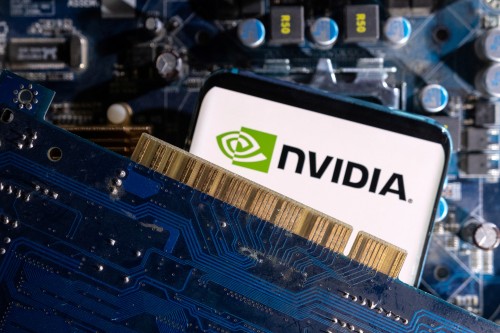By Arsheeya Bajwa
(Reuters) – Nvidia has bested lofty Wall Street revenue expectations for the past eight quarters. But as analysts expect a slower pace of growth, how the company overcomes delays and supply chain issues to sell its latest AI chips is likely to be a barometer for its stock price.
The chipmaker, which is at the heart of the generative artificial intelligence boom, is expected to report that its third-quarter sales surged 82.8% to $33.13 billion, according to data compiled by LSEG.
This would mark the slowest growth in six quarters, with its sales at least doubling in the previous five.
Growth for the fourth quarter ending January – which will include sales of Nvidia’s new Blackwell chips – is likely to slow further to 67.6%.
After design flaws brought on delays in ramping up production of the new series of processors, investors are keen to know whether Nvidia will be able to deliver on the promised “several billion dollars in Blackwell revenue” in the January quarter.
“It’s all about Blackwell right now from an investor perspective,” said Hans Mosesmann, an analyst at Rosenblatt.
Morgan Stanley analysts expect Blackwell revenue between $5 billion and $6 billion in the fourth quarter, while Piper Sandler analysts forecast a range of $5 billion to $8 billion in revenue from the chips that pack 30 times more speed than their predecessors.
Ivana Delevska, founder and chief investment officer of Spear Invest, which holds Nvidia shares in an actively managed ETF, is even more bullish. She expects these chips to bring in about $12 billion to $13 billion in the same period.
But Nvidia’s ability to deliver these chips may be limited by supply chain constraints. Capacity for the production of AI chips will be very tight going into 2025, Nvidia’s contract chip manufacturer TSMC said in July.
“It’s hard to read this with any precision, to be clear,” Morgan Stanley analysts said, adding that a change of even a week in the timeline for delivering Blackwell chips could have a meaningful impact on revenue.
Nvidia’s quarterly results face tough year-on-year comparisons following a surge in investments in AI infrastructure after the launch of OpenAI’s ChatGPT in late 2022, which was trained and runs on thousands of Nvidia graphics processors.
The company beat Wall Street’s revenue estimates by narrowing margins in the past four quarters.
Results at Nvidia, which has overtaken Apple as the world’s most valuable firm, will be instrumental in driving, or weakening a prolonged rally in AI-linked stocks. Nvidia’s own shares have nearly tripled this year.
Nvidia’s adjusted gross margin is expected to drop more than three percentage points to 73.6% in the fourth quarter, weighed down by the high cost of developing and ramping up the production of new AI chips.
Research and development costs and adjusted operating expenses are expected to be their highest ever in that period.
But demand for Nvidia’s leading GPUs will remain robust in the foreseeable future, analysts and investors agree.
Cloud service providers including Microsoft and Amazon are likely to keep investing billions of dollars to build out AI data centers that use Nvidia’s chips, as they race to develop the fastest, most sophisticated generative AI applications.
Nvidia’s proprietary CUDA software framework that developers use to program its processors is also helping it dominate the AI chip market, where it commands about 80% of market share.
The software has become “a really nice multi-billion-dollar annual recurring revenue business, operating at scale, still growing north of 100%,” said John Belton, a portfolio manager at Gabelli Funds which holds Nvidia shares.
(Reporting by Arsheeya Bajwa in Bengaluru; Editing by Aditya Soni, Sayantani Ghosh and Shounak Dasgupta)






